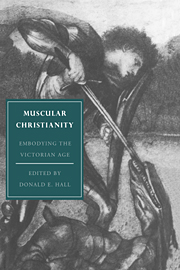Book contents
- Frontmatter
- Contents
- List of contributors
- Acknowledgments
- INTRODUCTION
- PART I FOUNDATIONS OF MUSCULAR CHRISTIANITY
- PART II VARIETIES OF MUSCULAR CHRISTIANITY
- 4 Charles Kingsley's scientific treatment of gender
- 5 Young England: muscular Christianity and the politics of the body in Tom Brown's Schooldays
- 6 Muscular spirituality in George MacDonald's Curdie books
- 7 “Degenerate effeminacy” and the making of a masculine spirituality in the sermons of Ralph Waldo Emerson
- PART III RESPONSES TO MUSCULAR CHRISTIANITY
- Index
5 - Young England: muscular Christianity and the politics of the body in Tom Brown's Schooldays
from PART II - VARIETIES OF MUSCULAR CHRISTIANITY
Published online by Cambridge University Press: 05 March 2010
- Frontmatter
- Contents
- List of contributors
- Acknowledgments
- INTRODUCTION
- PART I FOUNDATIONS OF MUSCULAR CHRISTIANITY
- PART II VARIETIES OF MUSCULAR CHRISTIANITY
- 4 Charles Kingsley's scientific treatment of gender
- 5 Young England: muscular Christianity and the politics of the body in Tom Brown's Schooldays
- 6 Muscular spirituality in George MacDonald's Curdie books
- 7 “Degenerate effeminacy” and the making of a masculine spirituality in the sermons of Ralph Waldo Emerson
- PART III RESPONSES TO MUSCULAR CHRISTIANITY
- Index
Summary
Perhaps the most significant body in Tom Brown's Schooldays is one that does not appear in the text itself: the body of Christ. As the word made flesh, the embodiment of the logos, Christ's materiality provides the doctrinal basis for Hughes's novel. Following F. D. Maurice, Hughes reads the incarnation as evidence of the value and sanctity of the human body and as the basis of human solidarity, the unity of all men as “brothers in Christ” (Vance 54–6). Thus Hughes's ideals of muscular Christianity, the interrelated development of the individual's physical and spiritual strength, and of Christian Socialism, the equality of all men, are grounded on the oxymoronic conjunctions of the material and the spiritual, and the individual and all mankind, in the incarnate Christ. Yet, even as it articulates Hughes's principles, Tom Brown's Schooldays reveals the ideological tensions inherent in his ideals. This essay will examine Hughes's attempts to resolve two of these tensions: the latent incompatibility of the values of physical prowess and spiritual aspiration that combine to form muscular Christianity and the conflict between the ideal of democratic equality that underlies Hughes's Christian Socialism and his implicit assumption of a middle-class perspective in the novel.
These ideological frictions are interrelated in Hughes's novel, the solution to one conflict providing the basis for another conceptual dilemma. Like Hughes's doctrine itself, the difficulties begin with a body or, rather, bodies: the ideologically charged bodies of Tom Brown and the boys of Rugby. The incommensurability of muscular Christianity's stress on both athleticism and spirituality first becomes apparent in Hughes's problems in depicting a body that adequately represents both values.
- Type
- Chapter
- Information
- Muscular ChristianityEmbodying the Victorian Age, pp. 114 - 132Publisher: Cambridge University PressPrint publication year: 1994
- 7
- Cited by



